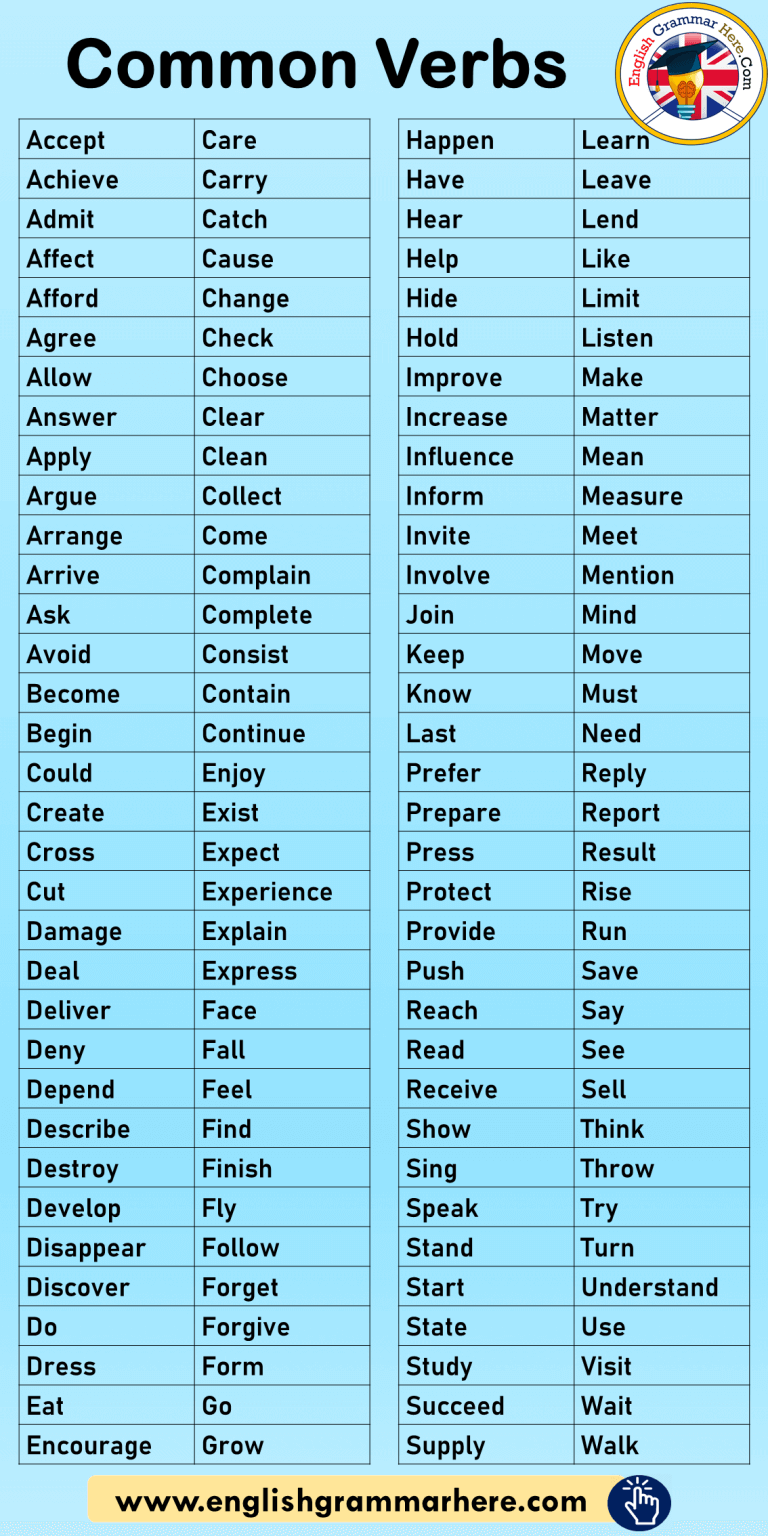Have you ever felt like you’re struggling to express yourself in English? Do you find yourself constantly searching for the right word? The answer might just lie in the verbs. Verbs are the heart of any language, the action words that bring sentences to life. And mastering the most common verbs in English can significantly enhance your communication skills, whether you’re writing a formal email or having a casual conversation.

Image: englishgrammarhere.com
This article delves into the world of English verbs, exploring the 100 most frequent ones and their applications. We’ll analyze their meanings, understand their usage in various contexts, and uncover how they form the bedrock of English vocabulary. By the end, you’ll have a solid understanding of these verbs, empowering you to communicate effectively and confidently.
The Building Blocks of Language: Understanding Verbs
Verbs, the dynamic components of language, describe actions, states, and occurrences. They provide the backbone to sentences, conveying what is happening, being done, or experienced. In essence, verbs answer the question, “What is happening?” or “What is being done?” For example, in the sentence “The cat sleeps,” the verb “sleeps” tells us the action being performed by the cat. Without verbs, sentences would be lifeless and lack any sense of movement or purpose.
100 Most Common Verbs in English: The Essential List
The 100 most common verbs in English form the foundation for clear and effective communication. They are the verbs you encounter most often in everyday speech, writing, and reading. Understanding these verbs is crucial for understanding the nuances of the English language.
Top 10 Most Common Verbs
- Be: (am, is, are, was, were, been, being) – Expressed states, existence, or identification. Example: I am happy.
- Have: (has, have, had, having) – Expresses possession, experience, or obligation. Example: She has a dog.
- Do: (does, did, done, doing) – Used for variety, emphasis, or to form negative sentences and questions. Example: I do my homework.
- Say: Expresses communication. Example: He said hello.
- Get: Expresses receiving, obtaining, becoming, or arriving. Example: I got a new car.
- Go: Expresses movement, direction, or progress. Example: They went to the store.
- Know: Expresses understanding or familiarity. Example: I know the answer.
- Think: Expresses mental activity, such as considering or believing. Example: I think it will rain.
- See: Expresses the act of observing or perceiving visually. Example: I see a bird.
- Come: Expresses movement towards someone or something. Example: She is coming home.

Image: www.pinterest.com
Verbs of Action, State, and Existence
- Action Verbs: These verbs express a physical or mental action. Examples: run, jump, read, write, eat, sleep, walk, talk, listen, watch
- State Verbs: These verbs describe a state of being or a condition. They often express feelings, thoughts, or senses. Examples: be, seem, feel, appear, look, sound, smell, taste
- Existence Verbs: These verbs describe existence or presence. Example: exist, live, remain, stay, survive
Beyond the Basics: Exploring Verb Forms
Verbs can take different forms depending on their tense, aspect, mood, and voice. Understanding these forms is essential for using verbs correctly and effectively.
Verb Tenses: Past, Present, and Future
Verb tenses indicate the time of an action or state. The three main tenses are:
- Past Tense: Describes actions that already happened. Example: He walked to the store.
- Present Tense: Describes actions happening now or habitual actions. Example: She eats breakfast every morning.
- Future Tense: Describes actions that will happen in the future. Example: They will travel to Europe next year.
Verbs and Their Aspect: Perfect, Progressive, and Simple
Verb aspect tells us about the duration, completion, or repetition of an action.
- Simple Aspect: Expresses a single action or state. Example: He reads a book.
- Progressive (Continuous) Aspect: Expresses an ongoing action. Example: She is reading a book.
- Perfect Aspect: Expresses an action that is completed in the past or has a result in the present. Example: He has read the book.
Mastering the Art of Communication: Using Verbs Effectively
Here are some tips for using verbs effectively in your communication:
- Choose Verbs Carefully: Select verbs that accurately convey your intended meaning. For example, use “walk” for a leisurely pace and “run” for a faster pace.
- Vary Your Verb Choice: Using the same verb repeatedly can make your writing or speech monotonous. Consider using synonyms or different verbs to add variety and interest.
- Use Active Voice: Active voice makes your writing more direct and engaging. Example: The dog chased the ball. (Active voice) vs. The ball was chased by the dog. (Passive voice)
- Consider Verb Tense and Aspect: Use the appropriate verb tense and aspect to communicate the time and duration of actions clearly.
100 Most Common Verbs In English
Conclusion: Empowering Yourself Through Verbs
By understanding the 100 most common verbs in English and their various forms, you can unlock a world of possibilities in your communication. These verbs serve as the building blocks of language, enabling you to express your thoughts, ideas, and experiences clearly and effectively. Embrace the power of verbs, and watch as your communication skills soar to new heights.






